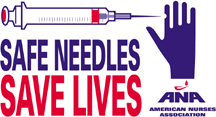Two new weapons released in battle against needlesticks

By Michelle Nawar
After years of efforts by ANA and other organizations, two major victories occurred in the ongoing struggle to protect health care workers from needlestick injuries: the publication of the new Occupational Safety and Health Administration (OSHA) Bloodborne Pathogens Standard Compliance Directive and the publication of the National Institute of Occupational Safety and Health (NIOSH) ALERT. RNs and other health care workers sustain 600,000 to one million needlestick and sharps injuries every year Ð resulting in at least 1,000 new cases of HIV, hepatitis C, or hepatitis B. Yet less than 15 percent of U.S. hospitals use safer devices, such as retractable needles. OSHA's Compliance Directive and NIOSH's ALERT will help reduce health care worker exposure to blood and prevent occupational transmission of AIDS, hepatitis B and C.
 |
| Assistant Secretary of Labor for OSHA Charles N. Jeffress presented a copy of the OSHA compliance directive to Susan Wilburn, MPH, RN, ANA Occupational Health and Safety Specialist. |
The Compliance Directive, published on Nov. 5, 1999, provides instructions for OSHA compliance officers (inspectors) when they inspect health care institutions to cite employers for failing to evaluate, purchase and implement safer needles and other safer sharps devices. Even if employers are using safer devices, they can be fined if they are not continuing to evaluate and purchase devices that are demonstrated to reduce injuries in their facility.
While ANA strongly supports the Compliance Directive, it is concerned that OSHA has no plans to enhance its enforcement programs or increase the number of OSHA inspectors. However, OSHA will conduct additional inspection in response to complaints. If your employer is not adhering to the Bloodborne Pathogens Standard as interpreted by the new Compliance Directive, contact your state nurses association (SNA) for information on how to file a complaint with OSHA. You have the right to file a complaint and remain anonymous with your employer. ANA is working closely with the SNAs to file complaints with OSHA.
While the Compliance Directive is a step in the right direction, more is needed. The directive does not:
* cover public employees
* amend the Bloodborne Pathogens Standard to require safer devices
* require the involvement of frontline health care workers in the evaluation, selection and implementation of the safer devices
* provide for needlestick injury surveillance that is useful to health and safety committees and occupational health programs to assess the device specific injury rates to improve the program and devices for prevention.
The ANA will continue lobbying for state and federal legislation that contains all of the above components.
On Nov. 22, 1999, NIOSH published an ALERT: "Preventing Needlestick Injuries in Health Care Settings." Unlike the Compliance Directive, employers are not required to adhere to the ALERT -- NIOSH has no enforcement power. However, the ALERT can assist employers in developing a strong needlestick prevention program that will adhere to OSHA's Compliance Directive.
For more information on the Compliance Directive, visit OSHA's website at http://www.osha.gov/. For a copy of the NIOSH ALERT, go to www.cdc.gov/niosh or call (800) 35-NIOSH and request Publication No. 2000-108. To learn more about ANA's Safe Needles Save Lives campaign, go to http://www.needlestick.org/.
Michelle Nawar is communications and education specialist at the American Nurses Association.
In Brief Political Nurse From the RN Files Media Briefs Miscellaneous
Staff Previous Issues Back to Nursing World
Advertise in The American Nurse
